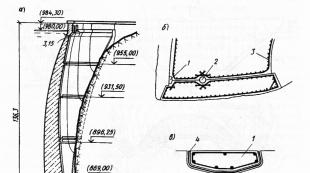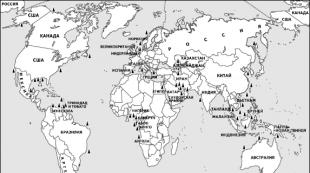Cruciferous plants presentation. Presentation "Cruciferous family". Edible plant organ
1 slide
CRUSIFELLA (brassicas), family of dicotyledonous plants. Herbs, less often subshrubs and shrubs. Over 3 thousand species (about 350 genera), mainly in the North. hemispheres. Among the cruciferous plants are vegetables (cabbage, radish), oilseeds (colza, rapeseed) and weeds (shepherd's purse, springberry), as well as melliferous, medicinal, dyeing and ornamental plants. Cruciferous.

2 slide
H 2+2, L 2+2, T 4+2, P 1 Fruits - pods, pods. Inflorescence raceme. Flower formula.

3 slide
Radish. Vegetables. RADISH (Raphanus), a genus of annual or biennial plants of the cruciferous (cabbage) family. 6-8 species, in Europe, Western Asia, North Africa. Radish (R. sativus) is a root vegetable crop. It has varieties - European (radish itself, radish), grown in many countries of the Northern Hemisphere, and Asian (Chinese - lobo, Japanese - daikon), widespread mainly in East Asian countries.

4 slide
Mustard. MUSTARD, a genus of annual and perennial herbs of the cruciferous family. 7-10 species, in Eurasia and Northern. Africa. White mustard (English) is grown; the seeds contain 20-34% mustard oil. Mustard is also called some types of cabbage - Sarepta mustard, black mustard (the seeds contain 35-45% oil), etc. Mustard powder (after pressing the oil) is used to prepare seasonings and mustard plasters. Honey plants. Many species are weeds.

5 slide
Cabbage. KAP USTA, genus of one-, two- and perennial plants of the cruciferous family, vegetable crop. OK. 35 species, in Eurasia and North Africa, most in the Mediterranean. Cultivated cabbage (in the heads of sugar, protein, vitamin C, minerals), cauliflower, savoy, Brussels sprouts, kohlrabi, etc. The cabbage genus also includes turnips, rapeseed, rapeseed, Sarepta mustard, rutabaga. Grown everywhere.

6 slide
Horseradish. Horseradish (Armoracia), a genus of perennial plants of the cruciferous (cabbage) family. 3 species, in Europe, the Caucasus and Siberia. Horseradish, or country horseradish (A. rusticana), is a vegetable crop. The plant is 50-150 cm high, with a fleshy white rhizome (“root”) and large leaves. The flowers are white, small, collected in a racemose inflorescence. Cultivated as an annual and biennial plant in Western Europe, Asia and America. In Russia - from the 16th century, everywhere. The leaves and roots are rich in vitamin C and mustard essential oil, which gives horseradish its pungent taste. Horseradish roots secrete phytoncides.

7 slide
Radish. RADISH (Raphanus sativus var. radicula), an annual or biennial plant of the cruciferous (cabbage) family; a type of radish. Radish leaves are strongly or weakly dissected, in a rosette of 4-6 pieces. The roots are round or elongated-conical, with red, pink, white, red and pink-white, yellow, purple or variegated skin. The flesh is usually white. The weight of the root crop is from 7 to 400 g or more. The flowers are relatively large, white or pinkish. Peduncle up to 1.5 m high. Cross pollination.

8 slide
TURNIP (Brassica rapa), a biennial root plant of the cruciferous (cabbage) family, vegetable and fodder crop (turnip). In the 1st year of life, the turnip plant forms roots and basal leaves, and in the 2nd year - flowers and seeds. The leaves are lyre-shaped, rough, and smooth (in salad varieties they are smooth). Root crops are flat-rounded, rounded or elongated, yellow, white, less often pink with green, purple, bronze and other heads; the flesh is white or yellow; weight 30-1000 g. Flowers on a long (50-150 cm) peduncle, golden or lemon yellow. Cross pollination. Turnip.

Slide 9
Camelina, a genus of annual herbs of the cruciferous family. 15 species, in Eurasia, Northern. Africa and North America. Spring camelina (sown) and winter camelina (forest) are cultivated as oilseeds. Ryzhik.

10 slide
Shepherd's purse. Medicinal. SHEPHERD'S PURSE, a genus of herbs in the cruciferous family. 5-7 species, in temperate and subtropical zones. Shepherd's purse - medicinal plant (infusion and liquid extract of herbs - mother plant), weed; young leaves are edible; a mustard surrogate is made from the seeds.
Family Cruciferous (Brassicaceae)
Completed by: Anna Porseva, 328 gr.

Taxonomy
- Kingdom: plants
- Department: angiosperms
- Class: dicotyledonous
- Subclass: rosids
- Order: brassicas
- Family: Cruciferous or cabbage vegetables

Spreading
Includes up to 380 births and more 3200 species, distributed mainly in the temperate zone of the Northern Hemisphere.
In the Udmurt Republic 25 births And 41 species .

Family characteristics
- Quadruple flower
- Stamens 4+2
- Most often they bloom with white or yellow flowers
Marsh fireweed (Rorippa palustris)

4. Inflorescence raceme
5. Flowers + Fruits at the same time
Field twig (Thlaspi arvense)
Arched cress (Barbarea arcuata)

6. Fruit pod or pod
Camelina sativa
Rapeseed (Brassica napus)

7. Leaves are simple, whole or dissected, devoid of stipules.
Cabbage (Brassica oleracea var. Capitata)
Field mustard (Sinapis arvensis)

Gooseberry officinalis
- annual
- The stem is pubescent
- Leaves are pinnately dissected, with oblong-ovate, unevenly toothed lateral lobes
- the upper leaves are spear-shaped or almost arrow-shaped, small, sessile.

- pods subulate, gradually tapering towards the apex
- Weeds in fields, hedges, roads, etc.
- Flowers in narrow, almost spicate racemes
- Quadruple flower
- yellow petals
- Stamens 4+2

Medicinal plants
In traditional medicine, horseradish root is used to prepare rubs for radiculitis and other diseases.
Horseradish (armoracia rusticana)

In traditional medicine, radish juice mixed with honey is used for coughs.
It is also used for cholecystitis and for the prevention of cholelithiasis.
Radish (raphanus sativus l.)

Mustard alcohol (2%) is used for rubbing for rheumatism, radiculitis, and sometimes for neuritis and colds.
Children use mustard foot baths and mustard wraps for inflammation of the respiratory system.
Sarepta mustard (brassica juncea czern.)

Ornamental plants
More often they are grown not so much for beauty, but for the smell, because cruciferous plants are good honey plants.
Alpine rhizome (Arabis alpina)
Lobularia maritima
(Lobularia maritima)
Cheiranthus cheiri

Economic importance
Oilseeds
- Cabbage
- Radish
- Turnips
- Mustard
- Ryzhik

Interesting Facts
Evening primrose (Night candle, Oslinnik, Lunnik)
As soon as the summer day is replaced by a short, warm night, evening primrose blooms its flowers. Fragrant, yellow, they flicker in the twilight, like the pale flame of burning candles. It is then that you begin to understand why this flower was nicknamed “Night Candle”.

Eutrema wasabi (Eutrema japonicum)
Wasabi- these are the light green, hot, aromatic roots of the herbaceous plant Eutrema wasabi. In Europe, wasabi is often called “Japanese horseradish.” It is curious that in wasabi root the taste properties are distributed unevenly: the upper part of the root vegetable (the one closest to the tops) is much sharper than the lower part.
Slide 1
Slide 2
 There are up to 380 genera and about 3,200 species in the family. Cruciferous plants successfully adapt to a wide variety of habitats. Some of them are confined to the extreme conditions of the highlands, reaching the boundaries of vegetation (4500-5700 m above sea level), where, together with lichens, they are pioneers of vegetation cover; others grow along sea coasts; some in their distribution move far to the north and are characteristic of the Arctic regions; others are inhabitants of deserts, semi-deserts and steppes. Cruciferous plants are also widely represented in forests, among steppe vegetation, in moist places and even in water, but plants of arid and dry habitats definitely predominate among them.
There are up to 380 genera and about 3,200 species in the family. Cruciferous plants successfully adapt to a wide variety of habitats. Some of them are confined to the extreme conditions of the highlands, reaching the boundaries of vegetation (4500-5700 m above sea level), where, together with lichens, they are pioneers of vegetation cover; others grow along sea coasts; some in their distribution move far to the north and are characteristic of the Arctic regions; others are inhabitants of deserts, semi-deserts and steppes. Cruciferous plants are also widely represented in forests, among steppe vegetation, in moist places and even in water, but plants of arid and dry habitats definitely predominate among them.
Slide 3
 Cruciferous leaves are alternate, with the lower ones often forming a basal rosette. The flowers are usually devoid of both bracts and bracts, not large, often very small, inconspicuous, but many are also beautifully colored, giving the plant great decorativeness. Cruciferous plants are adapted to both cross-pollination and self-pollination. The main pollinators are flies, bees, bumblebees; some species are pollinated at night by butterflies. Bees are attracted by the smell of honey-bearing species, as well as by the most colorful flowers.
Cruciferous leaves are alternate, with the lower ones often forming a basal rosette. The flowers are usually devoid of both bracts and bracts, not large, often very small, inconspicuous, but many are also beautifully colored, giving the plant great decorativeness. Cruciferous plants are adapted to both cross-pollination and self-pollination. The main pollinators are flies, bees, bumblebees; some species are pollinated at night by butterflies. Bees are attracted by the smell of honey-bearing species, as well as by the most colorful flowers.
Slide 4

Slide 5

Slide 6
 Cruciferous plants are adapted quite diversely. These are mainly species with wings, many species with small, light seeds that are easily dispersed by the wind, or with seeds trimmed with a wing. Among the cruciferous plants there are also a number of species that have hook-shaped outgrowths on their fruits. Thanks to this, they cling to the fur of animals and are carried by them. In some cases, the seeds are scattered due to the “efforts” of the plant itself.
Cruciferous plants are adapted quite diversely. These are mainly species with wings, many species with small, light seeds that are easily dispersed by the wind, or with seeds trimmed with a wing. Among the cruciferous plants there are also a number of species that have hook-shaped outgrowths on their fruits. Thanks to this, they cling to the fur of animals and are carried by them. In some cases, the seeds are scattered due to the “efforts” of the plant itself.
Slide 7

Slide 8
 Application in medicine. Affects the contractility of smooth muscles of various organs. This largely determines the hemostatic effect of the shepherd's purse. The effect of vitamin K contained in the herb, which increases blood clotting, is also important. Shepherd's purse preparations cause a slight decrease in blood pressure and stimulate intestinal motility. Used for atonic uterine bleeding in gynecological practice, as well as for gastrointestinal and other bleeding. There are indications for the use of the herb for acute and chronic nephritis.
Application in medicine. Affects the contractility of smooth muscles of various organs. This largely determines the hemostatic effect of the shepherd's purse. The effect of vitamin K contained in the herb, which increases blood clotting, is also important. Shepherd's purse preparations cause a slight decrease in blood pressure and stimulate intestinal motility. Used for atonic uterine bleeding in gynecological practice, as well as for gastrointestinal and other bleeding. There are indications for the use of the herb for acute and chronic nephritis.
Families Cruciferous (Cabbage) and Rosaceae
Chapter 3
Plant classification
6th grade
N.I. Chernetsova,
biology teacher

- Lesson Objectives :
- - introduce students to the distinctive features of plants of the cruciferous and rosaceae families;
- - show the economic importance of these plants;
- - teach how to make a morphological description of a plant.
- Basic concepts of the lesson :
- family Cruciferous;
- family Rosaceae

- Let's repeat:
- Systematics is the science of the diversity of organisms, combining them into groups based on related characteristics .
- The largest systematic unit is the department.
- The main characteristic of angiosperms is the presence of fruits with seeds.
- Community is one of the
systematic units.

- Choose the correct statements:
6. Plants that do not have organs are considered higher.
7. View- this is a group of individuals, similar in structure and vital activity, freely interbreeding with each other and producing fertile offspring, occupying a certain territory.

- Examination
- 1, 3, 5, 6, 7

- Testing knowledge and skills
- 1. Systematics is a science that studies:
- a) historical development of plants,
- b) cellular structure of living organisms,
- c) general characteristics of related groups of plants.
- 2. Systematic categories include:
- a) kingdom, b) community, c) flora, d) fauna.
- 3. The basic unit in taxonomy is:
- a) class, b) family, c) species.
- 4. A group of individuals similar in structure and vital activity, living in a certain territory, interbreeding with each other and producing fertile offspring is called:
- a) department, b) species, c) family.

- 5 . Modern higher plants that do not have flowers and fruits are grouped into divisions:
- a) red algae and bryophytes,
- b) bryophytes and pteridophytes,
- c) ferns and brown algae.
- 6 . A systematic category that unites closely related genera:
- a) species, b) families, c) classes.
- 7. A plant with two cotyledons reticulate veining of leaves, taproot system, belongs to the class of…….. plants.
- 8. Peas belong to the class of dicotyledonous plants. Name the number of cotyledons, type of root system, type of leaf venation.
- 9. Wheat has a fibrous root system, parallel veining of leaves. How many cotyledons does a wheat grain have?

- Let's repeat:
- 10. What two classes is the department of angiosperms divided into?
- 11. Name the characteristics of plants of the class dicotyledons.
- 12 . Name the characteristics of plants of the class monocots.


Signs of plants of the monocot class and the dicotyledon class
Signs
Class dicotyledons
Number of cotyledons in the embryo
Class monocotyledons
2 cotyledons
Root system type
1 cotyledon
Rod
Leaf venation
Reticulated or feathery
Flower
fibrous
Parallel or arc
Four-membered flower or five-membered flower with double perianth
Arrangement of conducting bundles
Presence of cambium
Three-membered flower, less often four-membered with a simple perianth
In the center or have the appearance of a ring
Vascular bundles are scattered throughout the stem
Have a cambium
Differentiation of bark and wood
No cambium
Well differentiated
Examples
Unclear differentiation
Peas
Wheat

Class Dicotyledons. Family Cruciferous ( Brassicas )


- Family Cruciferae
- More than 3000 species
- Herbs,
- less often shrubs

- Taxonomy
- Kingdom: plants
- Department:
angiosperms
- Class: dicotyledonous
- Subclass: rosids
- Order: brassicas
- Family: Cruciferous or cabbage vegetables

- Features of plants of the Cruciferous family
- Includes 3200 species, united into 350 genera
- Annual, biennial and perennial herbaceous plants
- Distributed in temperate latitudes,
- in the northern hemisphere
- very unpretentious
- Pollinated by insects
- The flowers are correct
- Inflorescence – brush
- Leaves simple, whole or dissected
- Some
- plants
- is formed
- root vegetable
- Fruit: pod, pod
- Fetus: dry, dehiscent

- Flower structure Cruciferous
- Double perianth (Sepals + petals)
- Cup: 4 sepals
- Whisk: 4 petals
- Stamens: 4 long and
2 short
- Pestle: 1
- Formula flower: H 4 L 4 T 4 +2 P 1

- Inflorescence: brush
- Arched cress (Barbarea arcuata)
- Field twig (Thlaspi arvense)
- Wild radish
- Shepherd's Purse

- Fetus
Types of fruits
Pod
Pod

- Fruit: pod or pod
- Rapeseed (Brassica napus)
- Camelina sativa

- The leaves are simple, entire or dissected, devoid of stipules.
- Field mustard (Sinapis arvensis)
- Cabbage (Brassica oleracea var. Capitata)

- Vegetables
- cabbage
- radish
- turnip

Cabbage
Brussels
Kohlrabi
Colored

- Garden horseradish
- Horseradish (armoracia rusticana)

- Wild plants
- Yarutka field
- Shepherd's Purse
- Gooseberry officinalis

- Wild plants
- Krupka
- Perennial turnip
- Wild radish

- Ornamental plants
- Levkoy
- Alyssum
- Night violet

- Ornamental plants
- More often they are grown not so much for beauty, but for the smell, because... cruciferous vegetables are good honey plants.
Alpine rhizome (Arabis alpina)
Lobularia maritima
(Lobularia maritima)
Cheiranthus cheiri

- Economic importance
Oilseeds
- Cabbage
- Radish
- Turnips
- Mustard
- Ryzhik

- Morphological description
- Cruciferous family Brassicaceae
- Mustard seeds Semina sinapis
- An annual herbaceous plant with a branched stem up to 150 cm high.
- Leaves regular, naked; the lower ones are lyre-shaped, dissected or separate; the middle ones are lanceolate, notched along the edge; the upper ones are entire, elliptical in shape.
- Inflorescence- brush.
- Flowers small, golden yellow, typical cruciferous structure.
- Fruit- cylindrical bare pods with an awl-shaped nose, deflected from the stem.
- Seeds almost spherical, about 1 mm in diameter, sulfur-gray, brown or light yellow (depending on the variety), clearly cellular.
- Blooms in May - June, the fruits ripen in June - July.
- Black mustard seeds (Brassica nigra (L.) Koch), characterized by pods tightly pressed to the axis, are allowed for use.
- It is unacceptable to use white mustard (Sinapis alba L.), whose pods are clearly thickened and densely covered with hard hairs.
- Both types - annuals
- White mustard (Sinapis alba)
- Black Mustard

- Interesting Facts
- Evening primrose (Night candle, Oslinnik, Lunnik)
As soon as the summer day is replaced by a short, warm night, evening primrose blooms its flowers.
Fragrant, yellow, they flicker in the twilight, like the pale flame of burning candles.
It is then that you begin to understand why this flower was nicknamed “Night Candle”.

- Eutrema wasabi (Eutrema japonicum)
Wasabi - these are the light green, pungent, aromatic roots of a herbaceous plant Eutrema wasabi .
In Europe wasabi often call "Japanese horseradish." It is curious that in the wasabi root the taste properties are distributed unevenly: the upper part of the root vegetable (the one closest to the tops) is much sharper than the lower one.

- Task No. 1. What plants "extra"?
- Currant
- Black radish
- Aster
- Wild radish
- Cabbage
- Shepherd's Purse

- Task No. 2. Fill the table
Cabbage variety
Edible plant organ
White cabbage
Kohlrabi
Colored
Brussels

- Study § 27, pp. 155 – 161;
Questions No. 1-4 (oral);
Assignment on page 160 No. 1.
- Homework:


- When creating the presentation, we used the flower diagram and inflorescence diagram proposed by teacher of biology and chemistry Lebedev Sergei Nikolaevich
- from the state educational institution boarding school of the Kostroma region .
"Early flowering plants" - Primroses. Like all buttercups, it is poisonous. Like all buttercups, it is poisonous; medicinal plant. They attract the first insects with bright flowers. Mill.). All ephemeroids are perennial plants. Leaves appear after flowering. Yellow goose onion (Gagea lutea (L.) Ker-Gawl. 1. Wind-pollinated. 2. Insect-pollinated.
“The Legume Family” - Assess your knowledge. - 12 correct answers – 5; -11 – 9 correct answers – 4; - 8 – 6 correct answers – 3; -5 or fewer correct answers – 2. Task No. 3. 1. Rosaceae; 2. Solanaceae; 3. Solanaceae; 4. Cruciferous; 5. Rosaceae; 6. Cruciferous. Identify the plants. Wild plants of the family.
"Cruciferous family" - Cabbage. Grown everywhere. Over 3 thousand species (about 350 genera), mainly in the North. hemispheres. Horseradish, or country horseradish (A. rusticana), is a vegetable crop. Radish (R. sativus) is a root vegetable crop. Weeds grow in damp places in meadows, pastures, wastelands, and near roads.
“Plants in containers” - Design in landscape style. By showing curiosity and imagination, you can create compositions that are impressive in their originality. You fix your gaze on such elements, involuntarily trying to examine the details. Decorating a container with flowering plants in a landscape style is an excellent solution.
“Family Rosaceae” - * Ch5 l5t p1 * - the flower is correct. Flower formula. ?. Rosaceae family. Economic value. Strawberry rose. Valuable fruit plants Hedges Preparation of medicines. Representatives of Rosaceae. Classification of plants. H - sepal l - petal t - stamen p - pistil.
“Family Asteraceae” - Series. Tripartite series is a medicinal plant. More than 1000 species, in cold and temperate zones, mainly in the mountainous regions of Eurasia. Many species are honey plants; thistle is a malicious weed. America. CHRYSANTHEMUM (Chrysanthemum), a genus of annual and perennial herbs and shrubs of the Asteraceae family.
There are 16 presentations in total









